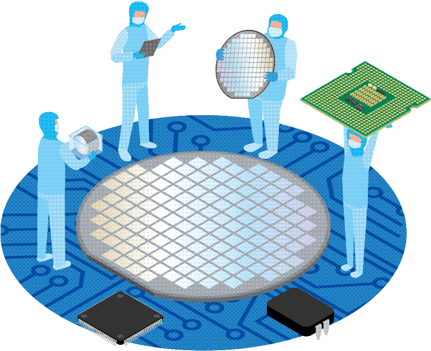> Tell me about chemically amplified resist
CAR is a flowable photoresist based on an organic nitrile compound dissolved
in a solvent system, which contains a very small percentage of a
tetrazole-containing monomer and a catalyst. during exposure to UV light,
this monomer splits into ammonia and a ketone byproduct while the catalyst
gets activated. at elevated temperatures, the tetrazole groups undergo a
chain reaction, causing the resist material to crosslink, forming insoluble
polymer networks that prevent further development with solvents or alkaline
solutions. the amount of crosslinking is proportional to the dose received
during exposure, allowing for selective removal during the developing process.
CAR offers several advantages such as better resolution due to its very low dark
resistivity, excellent flatness, and improved sensitivity compared to conventional
i-Line lithography processes.
> Which metals are typically used for making an ohmic contact to p-GaN,
and how does their thickness affect resistivity?
Commonly employed metals like Ni and Au can be utilized as p-type metalization
layers to establish efficient ohmic contacts with p-GaN regions in semiconductor
devices. The resistance offered by these layers depends on their respective
thicknesses; for instance, a thicker Ni layer would result in higher resistivity
compared to thinner layers. Consequently, optimizing the thickness ratios between
these metals is crucial for achieving desirable contact resistances and ensuring
reliable electrical performance within the circuits.
> Can you tell me about the use of AZ400K to form GaN nanowires?
Yes, AZ400K is a popular choice as a wet etch chemical solution for selectively
forming Gallium Nitride (GaN) nanowires due to its ability to etch GaN
anisotropically (along specific crystallographic planes) while leaving other
surfaces untouched. This leads to the formation of perfectly vertical wires with
minimal sidewall roughness or damage, making it an essential component in
fabricating devices like light emitting diodes (LEDs) or high electron mobility
transistors (HEMTs). The exact mechanism behind this selective etching behavior
is not fully understood but believed to be related to differences in surface energy
and polarity between various crystal planes of GaN.
> What temperatures are commonly used in the wet etching of GaN in AZ400K?
The temperature control is a crucial parameter during the GaN nanowire etching
process as it can significantly impact both selectivity and etch rate properties.
Commonly employed temperatures for AZ400K solution fall within the range of 40-80C
degrees Celsius, depending on application requirements and desired wire dimensions
or device structures. Higher temperatures generally lead to faster etching rates but
may also increase the likelihood of non-uniformity in diameter or sidewall damage
due to thermodynamic fluctuations. Conversely, lower temperatures result in slower
etch rates but improve selectivity and reduce the occurrence of unwanted surface
roughness or defects that could degrade device performance.
> How does the refractive index change with the density and quality of an oxide?
The refractive index is directly influenced by both the material's physical properties
(density) and its chemical composition (quality). A higher density generally leads to
a greater refractive index, while better-quality materials exhibit more consistent and
accurate refraction across various wavelengths. Therefore, ensuring proper control over
oxide deposition conditions such as temperature, pressure, and reactor chemistry is
essential for achieving desirable refractive indices in devices fabricated on top.



